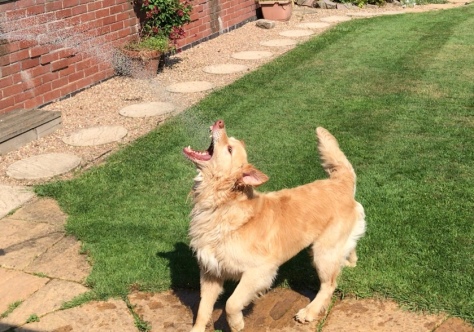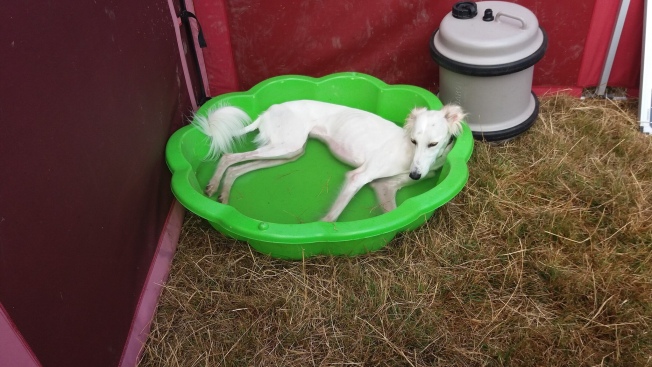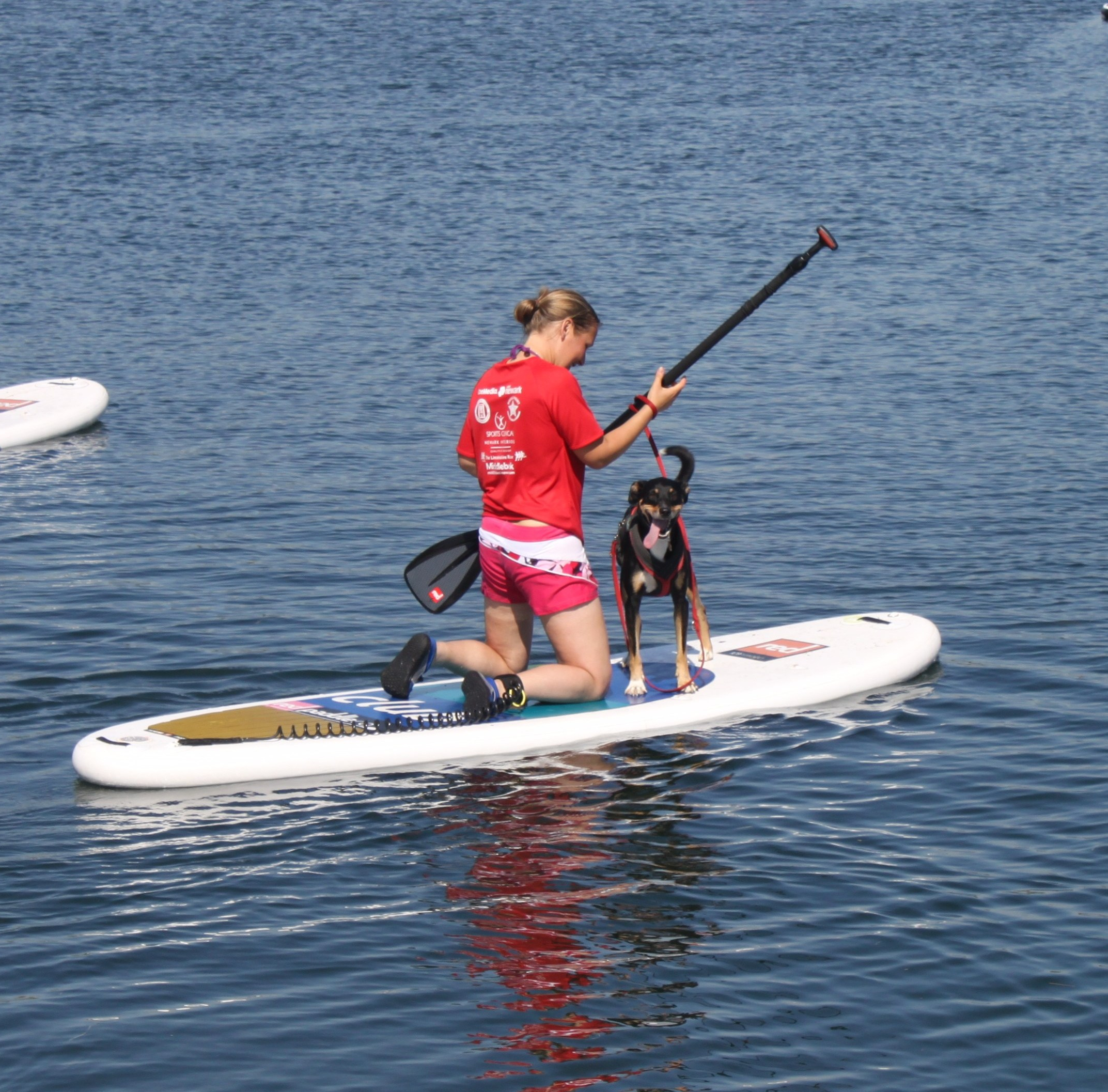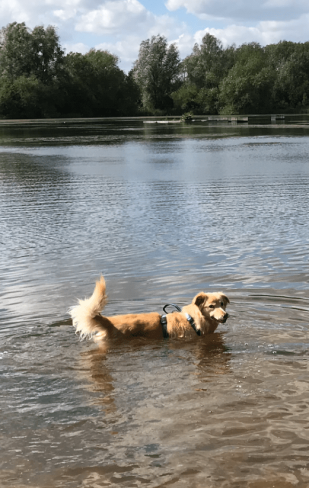The heatwaves currently sweeping the UK, Canada and Japan this year have already resulted in the loss of both human and canine lives. The UK’s Environmental Audit Committee warns the frequency of such heatwaves is likely to increase in the UK , with the number of human deaths potentially increasing three fold. We have been warned that society needs to be “better prepared” for such heat, so here at Hot Dogs Canine Research we’re starting now!
Firstly, some “false news”
Ice cubes are not dangerous to dogs, provided they are used appropriately. There has been a lot of misinformation on social media regarding ice cubes, with a recent story suggesting that a vet warned owners ice cubes could kill their dog. This story has been misinterpreted. A dog with heatstroke should not be cooled with ice. We’ll come on to why later in the post. A dog in a heatwave, getting fed up with the hot weather, can absolutely have the odd ice cube. Or iced dog food popsicle, or frozen cream cheese lick mat! A fit and healthy dog, will not suffer any ill effects from consuming frozen food or ice cubes, in the same way that we suffer no ill effects from ice lollies. They should be provided in moderation, and they should not replace constant access to clean, fresh, cool water.
Cooling a playful dog
If you have a dog that is a little too stupid to realise it is too hot to play (see Stevie below for a classic example), you should consider active cooling methods to stop them overheating. Stevie is partial to a hosepipe. He gets to play in the jet of water for a couple of minutes, then the hose is switched off. Dogs have died from water poisoning, so it is important to not encourage your dog to drink excessively when it is hot. Avoid lots of toy chasing/retrieving, or allowing dogs to snap at running water for prolonged periods. Stevie gets a couple of minutes, then the hose is switched off – moderation is the key.

Swimming or sitting in water is also a great way of keeping cool. Dog proof paddling pools are great – the inflatable ones often succumb to punctures from claws – and some dogs will choose to just climb in and lie down. Swimming in open water is not only a great way to cool down, but also excellent exercise for hot dogs. Sadly during summer blooms of blue-green algae can render small lakes and ponds dangerous to dogs, so keep an eye out for warning signs and learn how to recognise the problem here.
Cooling coats and mats are becoming increasingly popular, but be aware there is no robust evidence to support their use, yet. We are in the process of evaluating one, so watch this space for updates!
Cooling a hot dog
If your dog is hot from exercise, you may want to consider actively cooling them on a regular basis. Dogs do not sweat (apart from their paws) so they rely on panting, and losing heat from their body through radiation into the environment, or conduction to colder surface or liquid. There is some evidence that dogs may continue to overheat AFTER they have finished exercising – our study investigating cooling in dogs supports this finding in canicross dogs – so the risk of heatstroke doesn’t end just because the exercise had.
There is very little robust scientific evidence to support any specific cooling method.
Studies have been done cooling dogs with heatstroke, but none to date simply cooling dogs post exercise. Our advice at the moment, is to first know your dog and trust them. If they are dragging you to the nearest puddle, lake or water bucket, chances are they are looking to cool themselves down. Let them. Most dogs will get out when they’re comfortable.
If like Murphy here (on the paddle board), your dog likens water to a dog eating monster, you may struggle to get them into a paddling pool or stream for a quick dip. Applying water with spray bottle, or sponge to the legs, inner thighs, belly and neck is the next best advice. Dogs with a heavy coat and become water logged, and can take an age to dry, so targeting the areas with less hair, like the belly and thighs, can provide some relief, without causing too much of a wet dog smell.

Allowing your dog to drink is incredibly important. Dehydrated dogs get hotter when exercising , and are at greater risk of heatstroke. If your dog has been unwell, especially with diarrhoea or vomiting, they are more likely to be dehydrated, so ideally don’t allow them to exercise until they are fully recovered. Allowing your dog to drink tap water (typically between 10-15oC depending on the time of year) will help them to cool, and maintain hydration. Again you need to know your dog. If they are likely to drink a 2 litre bowl dry in one sitting and ask for more, you may need to stagger their intake, but most dogs will drink as needed.
Cooling a dog with heatstroke
Again, there have been several stories on social media regarding cooling dogs with heatstroke, very few backed by up solid science.
What we do know, comes from the dark days of science well before the Animals in Scientific Procedures Act 1986 legislation. Dogs were heated to the point of collapse, or unconsciousness. This study found that comatose dogs cool differently and much slower than conscious dogs with heatstroke. We know that dogs presenting to vets in a coma tend to have a poor prognosis for survival, likely due in part to their inability to effectively cool.
A conscious dog with heatstroke was found to cool quickest when immersed in water at 15-16oC. These dogs climbed out of the water baths themselves once they had recovered.

The comatose dogs cooled much slower than the conscious dogs, largely because they stopped panting. Their rate of cooling was similar in water temperatures ranging from 1 to 16oC, however, two of the dogs cooled with ice water died immediately following immersion in the water. These dogs started shivering once they were place in the ice water bath, which could have caused further elevation in body temperature contributing to their deaths. When placed in water above 18 degrees, the dogs cooled more slowly.
In an emergency situation, the current best available advice for treating heatstroke is to continuously pour tap water over the dog, with as much air movement as possible, a fan or air conditioning is ideal. Do not delay getting the dog to a vet, especially if they are already comatose. These dogs need emergency care to maintain their blood pressure and try to save their brain, kidney and liver function. Cool the dog quickly, then transport them whilst maintaining air flow (windows down or air con on in the car) to the nearest available vet. Try not to lay things over the dog, like wet towels, as this could restrict air flow to the skin and could reduce heat loss.
The single most effective way to ensure a dog’s survival, is to prevent heatstroke from happening.
Once heatstroke has occurred, rapid action is required. If the dog is still conscious, allow them to drink a little, and cool them with tap water. Seek veterinary care quickly. If the dog has already lost consciousness, every single second counts. Rapid cooling, then ideally continue cooling on route to the vet.
If its hot outside, chill out! Lie back, put your feet up, and enjoy a nap like Monty here.




41 thoughts on “Cold as ice: Keeping hot dogs cool.”